Day 1 of a two day Private Tour in North Norfolk today. We were lucky with the weather today – dry with some bright spells and even some blue sky at times, albeit with a rather fresh southerly wind and cloudier in the afternoon.
Our first destination for the day was Holkham. As we drove up along Lady Anne’s Drive, a pair of Egyptian Geese were out on the grass in one of the fields and we could see several Teal and a larger group of Wigeon around the edges of the pools.
As we got out of the car, we could hear lots of Pink-footed Geese calling. As it is full moon in a couple of days time, they had possibly been feeding inland overnight rather than roosting here and were therefore in no hurry to head out to the fields again this morning.
The Pink-footed Geese were rather jumpy this morning. Something disturbed them, although we couldn’t see what it was, and about 10,000 birds took off and filled the skies. It was an impressive sight, and sound. A small number flew off over our heads, but most settled straight back down on the grass. A little group landed much closer and we got them in the scope. We could see their pink-legs and feet in the short grass, glowing in the morning sunlight, as well as their small, dark bills with a narrow band of pink.
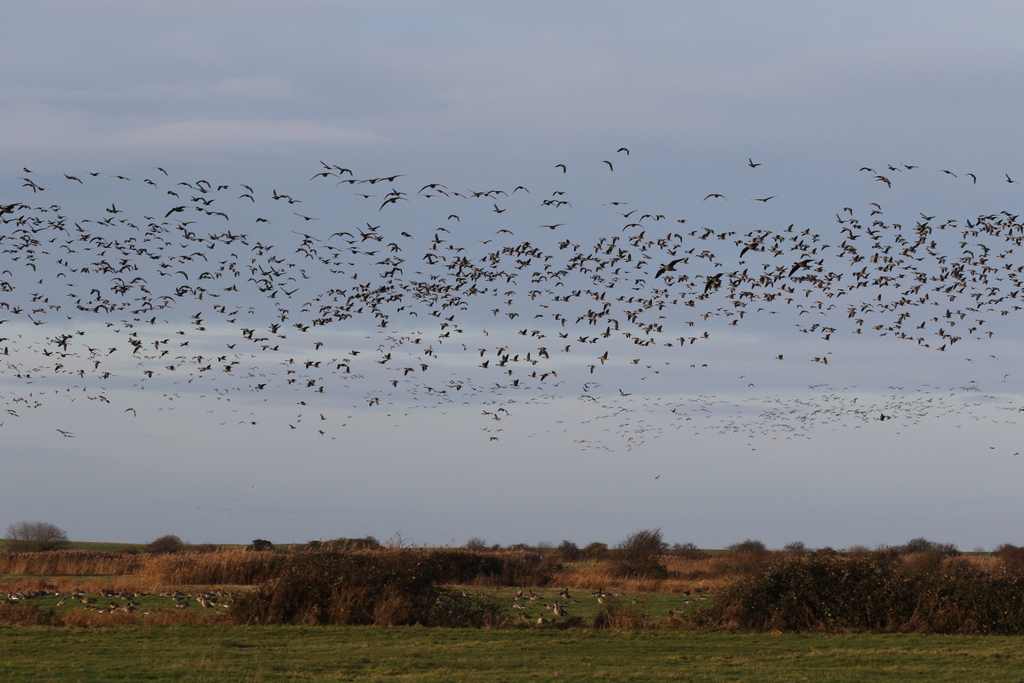
A large white bird came up out of the reeds in the distance, in front of Washington Hide. A Great White Egret, it circled round but quickly dropped back down again behind the line of sallows. A very pale buzzard flew over, flashing a white base to the tail as it disappeared off towards the Park, but it was just the regular pale Common Buzzard which can usually be found hanging around here, rather than something rarer.
As we made our way up to the pines, a big flock of Lapwings flew up from the grazing marshes over towards Wells. There were lots Curlews out here too, on the fields beyond The Lookout café, although it is rather hard to see past the new building! Walking along the boardwalk through the trees, we flushed several Jays from the ground which flew up into the pines.
Out on the saltmarsh the other side, a small group of Brent Geese were feeding in the short vegetation. We stopped to look at them, all the regular Dark-bellied Brent Geese, here for the winter from their breeding grounds in Siberia. We could see a good number of stripy-backed juveniles in with the adults, suggesting it was a better breeding season in 2018 than it had been last year.
We walked east on the path on the edge of the saltmarsh. As the new cordoned off area came into view, we spotted a large flock of small birds whirling around out in the middle. They were Snow Buntings, we could see the white flashing in their wings as they turned, at least 60 of them. They landed back down on the open sand at the far end of the cordon, so we made our way over for a closer look.
When we got to the fence, we noticed some other birds moving about on the edge of the vegetation out in the middle, the Shorelarks, just what we were hoping to see here today. They were very well camouflaged, and hard to see until they moved, but through the scope we could see their yellow faces and black bandit masks. Smart birds!
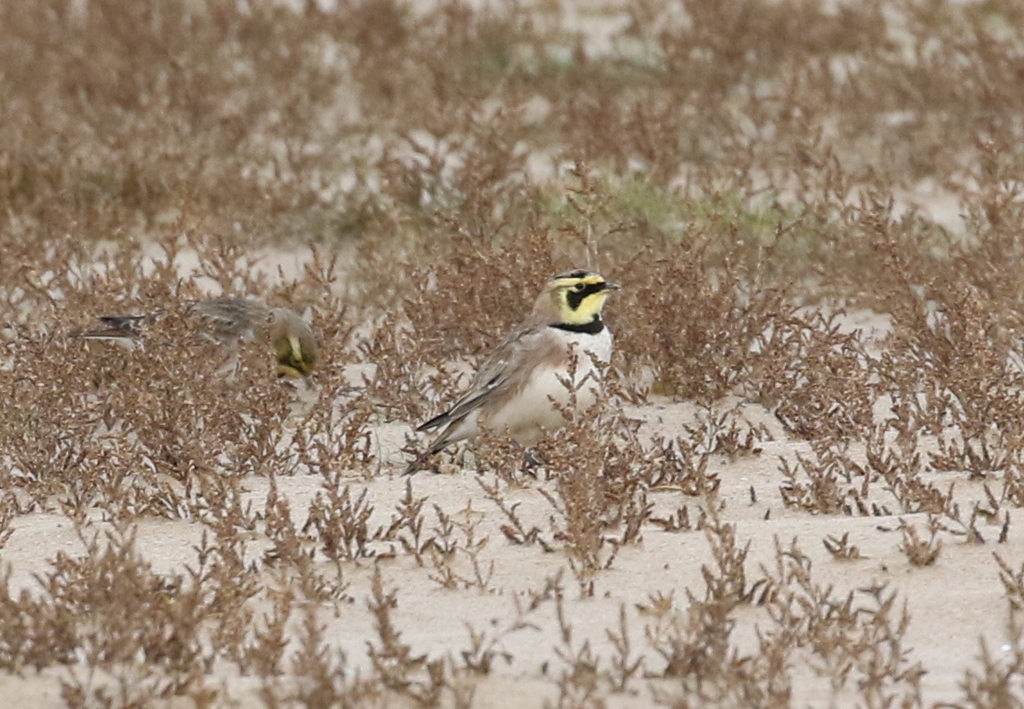
There were at least seven Shorelarks already here, possibly more hiding in the vegetation beyond. Scarce winter visitors here from Scandinavia, this is one of the best places in the country to see them.
The Snow Buntings were very flighty, as usual, and the next thing we knew they flew back over and landed on the sandy path ahead of us. They were feeding along the edge of the dunes, on the tideline, presumably looking for seedheads washed up from the saltmarsh. It looked like they might come straight past us, but then they were off again.
Once we had finished admiring the Shorelarks, we set off towards the beach. The Snow Buntings had landed again on the sand at the far end of the cordon and seemed completely unfazed by us walking past. We could see a variety of different shades, some much paler, whiter birds, some browner – a diverse mixture of ages and sexes, as well as birds from both the Scandinavian and Icelandic races.
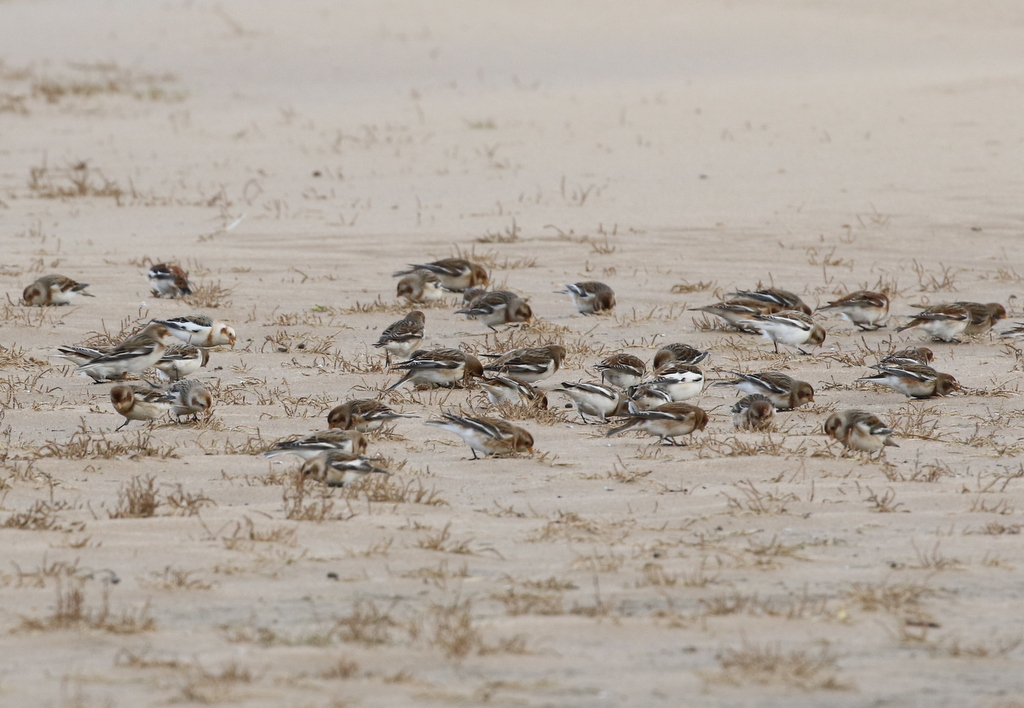
The tide was out, which meant there was quite a bit of beach between us and the sea. There were lots of gulls and Oystercatchers down by the sea, and several Cormorants drying their wings on the sandbar beyond. A large flock of Sanderlings whirled round on the shoreline off to the east.
Scanning the sea, we could see several Guillemots on the water, their white faces catching the light. A much larger bird was swimming just offshore beyond the sandbar, a Great Northern Diver. Similarly black above and white below, we could see its large dagger of a bill and black half collar.
There were a few ducks on the sea too, but they were a long way offshore today. We got a distant flock of Common Scoter in the scope, and could see the pale cheeks and dark caps of the females and young birds. One of the scoter flapped its wings and flashed a white panel, a Velvet Scoter, but it was impossible to pick out of the flock on the sea at that distance and unfortunately it didn’t repeat the wing-flap which singled it out from the others. A female Red-breasted Merganser much closer in was much easier to see.
There were several Great Crested Grebes on the sea too, black and white too but much longer-necked than the diver. Then we picked up two much smaller Slavonian Grebes just off the beach a long way off to the west around the bay. We had a look at them through the scope and thought about walking over to get a bit closer but it would probably have meant getting wet feet so thought better of it!
It had been a very productive couple of hours at Holkham, and we still had an hour before we had to pick up someone else in Wells. We decided to pop into the woods there for a quick look to see if we could find any redpolls – they are very mobile and consequently very hit and miss, so they would either be there or not!
The Brent Geese were starting to gather on the old Pitch & Putt course along Beach Road as we drove past. As we walked into the woods, a couple of Little Grebes were on the edge of the reeds on the boating lake, with some Tufted Ducks over towards the back.
It was very quiet at first, as we made our way through the trees, just the odd Robin or Wren calling, and one or two Blackbirds. As we approached the Dell though, we could hear Redpolls calling quietly, and we looked up into the birches ahead of us to see several of them feeding on catkins in the tops. They were against the light here and hard to see clearly, but the more we looked the more we could see. There appeared to be at least fifty of them in total.
We walked quietly underneath them and up onto the dune the other side, where the light was better. From here, we could see they were mostly Mealy Redpolls (the Scandinavian race of Common Redpoll), and we had a good view of several through the scope, including one male with a lovely pinky-red wash on its breast. A smaller, browner one with them was a Lesser Redpoll.
The Redpolls were mobile, moving through the trees, and it was impossible to get a good look at all of them from any one point. They were busily feeding on the catkins and we could see showers of chaff falling like snow from the birches. We couldn’t see any sign of an Arctic Redpoll from here though, so we moved round again to get a different angle and try some other trees.
It took a bit of searching, but eventually we found a much paler Redpoll in with the others. Through the scope, as it moved, we could see it had a plain white rump and thick undertail coverts with a single narrow dark streak. It was the Arctic Redpoll we had been looking for. More specifically, it was a Coues’s Arctic Redpoll, the race we get most often here, also from Scandinavia but from further north than the Mealies. We all managed to get a good look at it before it moved back into the tops. Then suddenly the flock erupted from the trees and flew off.
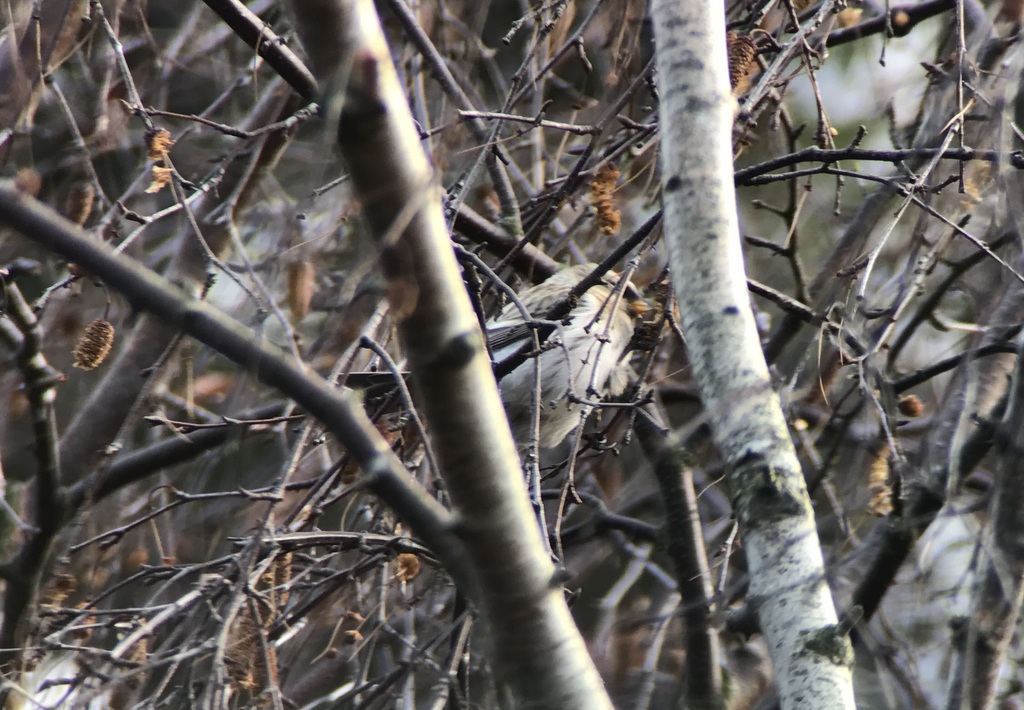
We still had enough time to walk a quick loop around the far side of the Dell, but we couldn’t find any sign of a tit flock in here today. Then it was back up to Wells to pick up the other member of the group. After a quick break for lunch in the pub in Stiffkey, we carried on east along the coast road to Cley.
We didn’t have enough time to explore the reserve at Cley today, but we wanted to have a quick look at the sea. A Common Buzzard was perched on a post by the Beach Road, and another large flock of Brent Geese was feeding out in the Eye Field. From up on the shingle, it didn’t take long to find our target here – a Red-throated Diver. There were actually quite a few here, mostly a long way offshore, but we eventually got a decent view of one through the scope. There were several Guillemots offshore too.
As we made our way back along Beach Road, we looked across to see all the ducks flush off the reserve. A Marsh Harrier was flying over and had spooked them, surprisingly the first we had seen today. We headed round to Blakeney, and as we pulled up we noticed a male Stonechat on the brambles on the edge of the grazing marshes, right next to where we had parked.
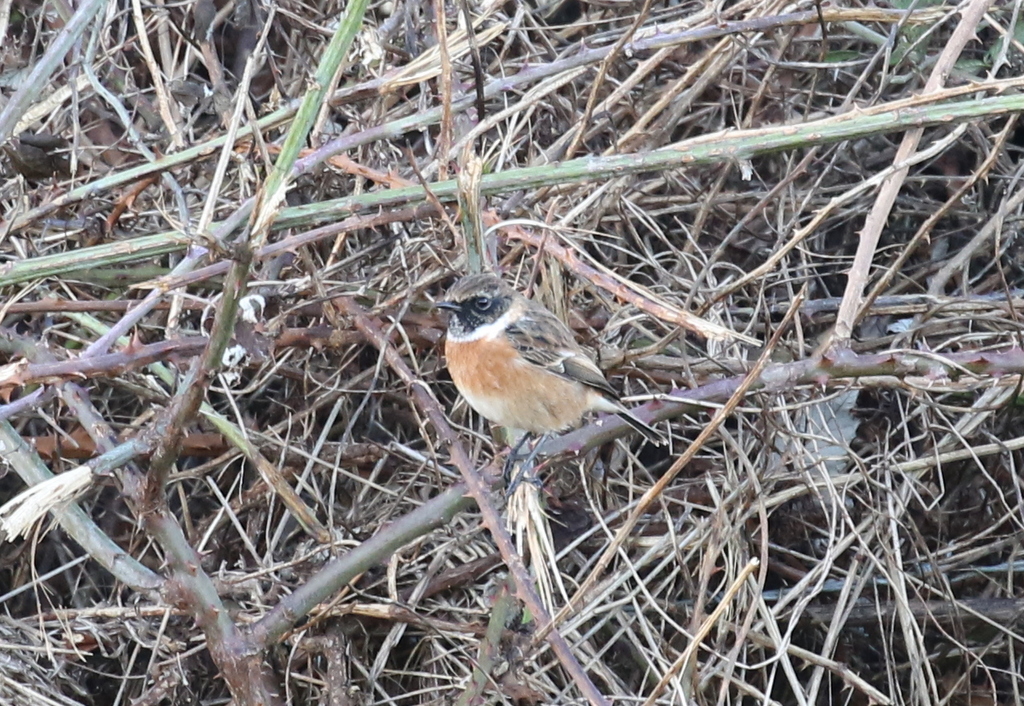
We were hoping to catch a Barn Owl out here this afternoon, and as we stopped to look at the Stonechat, one flew across the grazing marsh right in front of us. A very good start! It headed off towards the seawall, so we walked round that way to see if we could find it again.
Despite the fact they don’t count, it is impossible not to admire some of the captive ducks and geese in the rather random wildfowl collection by Blakeney Harbour. The large gull on the platform here was also an oddity – with a darker mantle than a Herring Gull, but lighter than a Lesser Black-backed Gull, and odd pinky-yellow legs, it is a Lesser Black-backed x Herring Gull hybrid. It is a regular here, coming back each winter, to take advantage of the food put out for the ducks.

Out on the seawall, there was no further sign of the Barn Owl. A Curlew was feeding on the sand on the far side of the channel. Several Marsh Harriers were circling out over the reeds in the middle of the Freshes, gathering to roost, and a couple more were having a last patrol out over the saltmarsh. One Marsh Harrier landed in a bush, where we could get it in the scope.
Their high-pitched yelping calls announced a group of Pink-footed Geese coming up off the grazing marshes. We looked across to see several hundred more hiding out in the grass. As we walked out along the seawall, more and more of them took off and headed off inland.
Out over the saltmarsh, a flock of about twenty small birds flew up and circled round, their distinctive bouncy flight helping to identify them as Linnets. From the corner of the bank, we stopped to scan the open mud. There were lots of waders out here, a mixture of small Dunlin running around, larger Grey Plover and Redshank, and larger still Black-tailed Godwits and Curlew, all with different shaped bills and different feeding actions. There were lots of Shelduck too.
It was a great view as the sun set behind the clouds away to the south-west as we walked out, but with the shortest day tomorrow, the light started to go quickly now. We started to make our way back. As we looked across to the far side of the Freshes, we could see another Barn Owl hunting as it came up from behind the reeds. It was a long way off though.
We thought the Barn Owl might come round to our side, but it turned and went back the other way. As we stopped and watched it, we could hear Bearded Tits from the reeds nearby, although they typically kept themselves tucked well down out of the wind. It was time to call it a day, so we made our way back to the car. We had enjoyed a good day out today – let’s see what else tomorrow brings.
















